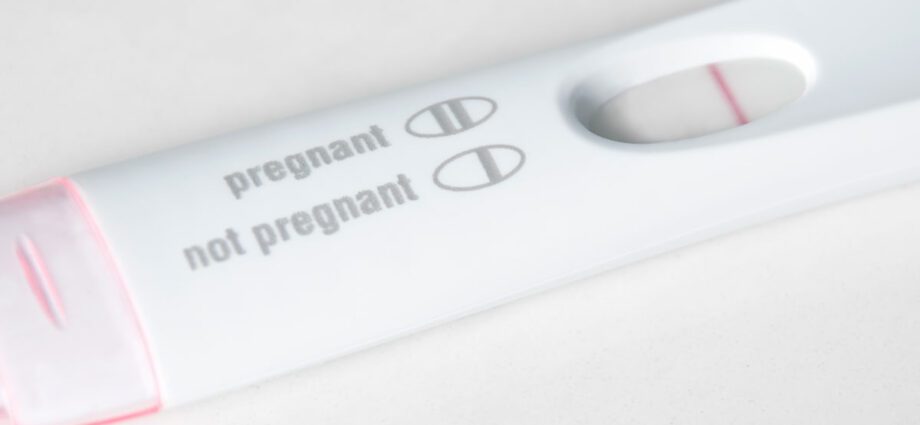Contents
- False positive or false negative pregnancy tests: definitions
- Negative pregnancy test but pregnant: the explanation
- Pregnancy test: when should it be done to be reliable?
- Why shouldn’t you read a pregnancy test after 10 min?
- Pregnancy test: give preference to blood tests to be sure
- Testimonial: “I had 5 false negatives! “
- In video: Pregnancy test: do you know when to do it?
If the pregnancy tests have a reliability of around 99%, there may be times when an error is displayed when the result is displayed. We then speak of false positive, very rare, or false negative.
False positive or false negative pregnancy tests: definitions
The false positive occurs when a woman who is not pregnant takes a pregnancy test that shows a positive result. Extremely rare, a false positive may be seen when taking medication for infertility, a recent miscarriage, an ovarian cyst, or kidney or bladder dysfunction.
The false negative occurs when the pregnancy test is negative even though one is pregnant, that a pregnancy has started.
Negative pregnancy test but pregnant: the explanation
The false negative, which is much more common than the false positive, occurs when the urine pregnancy test shows a negative result while a pregnancy is in progress. False negatives are most often the result of improper use of pregnancy test : the pregnancy test was taken too early for thebeta-HCG hormone could be detected in the urine, or the urine was not concentrated enough (too clear, not containing enough β-HCG), or the pregnancy test used was expired, or the result was read too quickly, or too late.
Pregnancy test: when should it be done to be reliable?
In view of the risk, even low, of false negative or false positive, one quickly understands the interest of well following the instructions at the level of the level of the use of a pregnancy test, at the risk of being frightened. ‘to have a huge disappointment, depending on the outcome you hope for.
A urine pregnancy test should preferably be performed with the first urine in the morning, because these are more concentrated in beta-HCG. Otherwise, if you do it at another time of the day, exceptionally try not to drink a lot in order to have urine richer in beta-HCG hormone. Because even if the pregnancy hormone beta-hCG is secreted from the 10th day following fertilization, its quantity may be too small to be immediately detected by a urine pregnancy test sold in pharmacies, drugstores or even supermarkets.
As for the date on which it is recommended to perform a pregnancy test, the instructions and instructions for use are generally quite clear: it is advisable toat least wait for the expected date of menstruation. If there are so-called “early” pregnancy tests capable of detecting pregnancy up to four days before the expected period, these are much less reliable, and the risk of false negative or false positive is therefore bigger. The later a test is done after the expected period (several days later, for example), the more reliable this pregnancy test will be.
Also, pay attention to the control window: a bar must be there, otherwise the test may not have worked well, whether it is out of date, damaged or otherwise.
Why shouldn’t you read a pregnancy test after 10 min?
The reason why a urine pregnancy test should not be read after ten minutes after taking it is because the result displayed may change over time. It is essential to follow the instructions in the instructions, namely, in general, read the result after one to 3 minutes. After the time recommended on the instructions, a dummy line may appear or on the contrary disappear due to various factors (humidity, evaporation line, etc.). No matter how tempting, there’s no point going back to looking at your pregnancy test result more than ten minutes after you’ve done so.
If in doubt, it is better to redo a urine pregnancy test a day later, with the first urine in the morning, or, better, to take a blood test for a beta-HCG dosage in the laboratory, for even more reliability. . You can always then go to your doctor to give you a prescription for reimbursement of this blood test.
Pregnancy test: give preference to blood tests to be sure
If you have any doubts, for example if you experience symptoms of pregnancy (nausea, tight breasts, no periods) when the urine test is negative, or simply if you want to be 100% sure, make an appointment with a health professional (general practitioner, gynecologist or midwife) so that they can prescribe a plasma beta-HCG assay. On prescription, this blood test is entirely reimbursed by Social Security et 100% reliable.
Testimonial: “I had 5 false negatives! “
« I have done 5 different brands of pregnancy tests in the past two weeks, and each time they were negative. Even digital was! However, thanks to a blood test (I had too many doubts), I saw that I was three weeks pregnant. So there you have it, so for those who have doubts, know that only the blood test is not wrong.
Caroline, 33 years old










